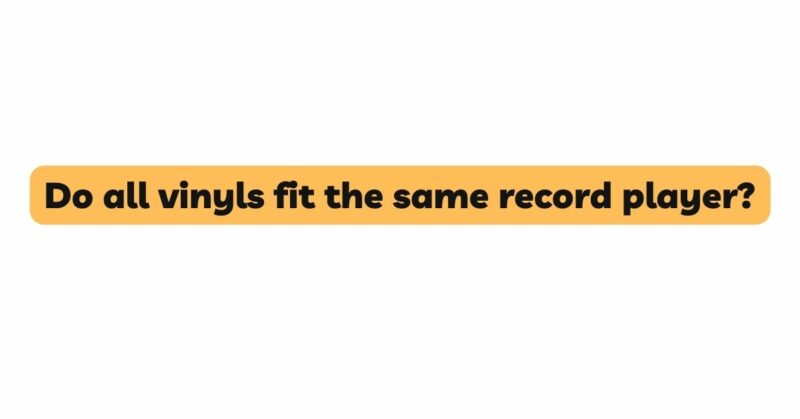In the age of digital music dominance, vinyl records have staged a remarkable comeback, captivating audiophiles and music enthusiasts with their warm, nostalgic sound and tangible appeal. However, as vinyl’s resurgence continues, questions arise about the compatibility between vinyl records and record players. Are all vinyls universally compatible with any record player? This article delves into the intricate world of vinyl and record player compatibility, uncovering the nuances that determine whether all vinyls fit the same record player.
The Vinyl Renaissance
Vinyl records have rekindled a passion for analog sound reproduction, offering a sensory experience that digital formats often lack. The tactile sensation of handling a vinyl, the crackle and pop of the needle settling into the grooves, and the distinct timbre of the music playing through a turntable create a unique connection to the music. This revival has sparked interest among both seasoned collectors and younger generations seeking to explore a different facet of music appreciation.
The Anatomy of a Vinyl Record
To comprehend the compatibility challenges between vinyl records and record players, it’s essential to understand the composition of a vinyl record. A vinyl record comprises grooves, which are physical indentations containing audio information. The grooves are read by a stylus, or needle, on a record player, which translates the groove’s variations into sound. The size, speed, and shape of these grooves, along with the material used to press the record, all contribute to the record’s unique sound quality.
Record Player Essentials
Record players, also known as turntables, consist of various components that interact with the vinyl record to produce sound. These components include the platter, tonearm, cartridge, stylus, and phono preamp. The platter holds the vinyl record and provides stability for accurate playback. The tonearm holds the cartridge, which houses the stylus. The stylus reads the grooves of the record, translating the physical information into electrical signals. These signals then pass through the phono preamp, which amplifies and equalizes the audio before sending it to external speakers.
Compatibility Factors
While the concept of vinyl and record player compatibility seems straightforward, several factors influence whether all vinyls fit the same record player:
- Vinyl Size: Vinyl records come in various sizes, including 7-inch, 10-inch, and 12-inch diameters. Each size requires a turntable with a corresponding platter size. Attempting to play a smaller record on a larger platter can lead to tracking issues, sound distortion, and potential damage to the record.
- Playback Speed: Vinyl records are commonly recorded at three speeds: 33⅓, 45, and 78 revolutions per minute (RPM). Turntables are equipped with speed settings to match these playback speeds. Playing a vinyl at the incorrect speed alters both pitch and timing, affecting the music’s intended sound.
- Cartridge and Stylus Compatibility: Different cartridges and stylus profiles are designed for specific types of records. Moving Magnet (MM) and Moving Coil (MC) cartridges have distinct characteristics that influence how they track different types of grooves. Using an incompatible cartridge or stylus may result in poor audio quality and increased wear on the vinyl.
- Tracking Force and Tonearm Weight: Vinyl records have a recommended tracking force, which is the downward pressure the stylus applies on the grooves. Turntables have adjustable tonearms to achieve the optimal tracking force for a specific cartridge. Using a mismatched tracking force can lead to excessive wear or skipped grooves.
- Phono Preamp and Equalization: Vinyl records use a specific equalization curve during recording to compensate for the limitations of the medium. Turntables include a phono preamp that applies the correct equalization curve for playback. Some modern record players have a built-in phono preamp, while others require an external one. Mismatched equalization can result in altered sound quality.
- Condition of Vinyl and Equipment: The condition of both the vinyl record and the record player significantly influences compatibility. Dust, dirt, and scratches on the record can affect playback, while a poorly maintained turntable may not accurately reproduce the audio.
Conclusion
In the enchanting world of vinyl records and record players, compatibility is a multifaceted puzzle. While the allure of vinyl lies in its timeless charm and analog sound, the harmony between vinyls and record players depends on various factors. From vinyl size and playback speed to cartridge compatibility and equalization, each component plays a pivotal role in ensuring an optimal listening experience.
As vinyl continues to captivate music enthusiasts, understanding these compatibility considerations becomes essential for those seeking to embark on their vinyl journey. By grasping the intricacies of vinyl and turntable interaction, audiophiles can immerse themselves in the rich, textured soundscapes that vinyl records have to offer, ensuring that every note resonates with the intended depth and warmth.

